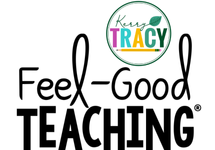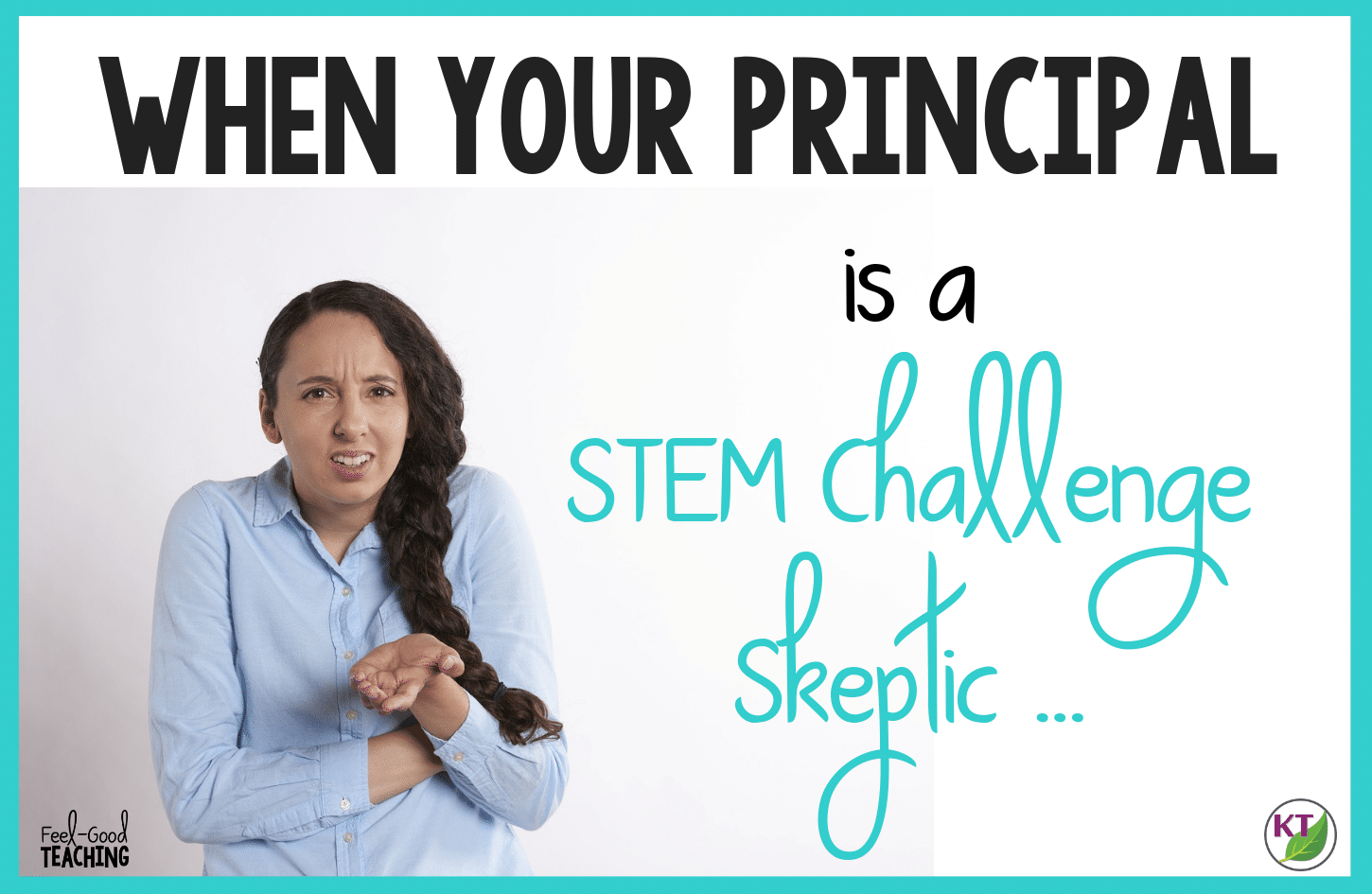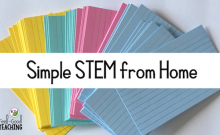In an ideal world, you and your principal would always be on the same page when it comes to what is best for students. You would never need to take precious time from your day to justify your philosophy and why you do what you do in your classroom. Your professional judgment would be trusted. If you do find yourself in that situation, be grateful, for many teachers do no find themselves in this ideal world. The good news is, even if you and your admin. are at odds, you can forge a path to understanding!
Never fear, there is hope! A STEM Challenge skeptic can be converted to an ally! Below, you’ll find a handy step-by-step list for dealing with a skeptical administrator. Obviously, it is written as it relates to STEM Challenges, but you’ll find the steps useful in working through many differences! More detail on each step can be found within or below the video.
Steps to Converting a STEM Challenge Skeptic
Remember your goal
Ask your principal to share his/her concerns
Establish common ground
Express your professional assessment
Provide evidence
Rather Watch the Video?
We chatted about these steps on a Facebook Live. I’ve included it here in case you’d rather watch than read. Though the content is largely the same, there are things in the written content below that aren’t in the video and vice-versa.
1. Remember your goal
If you’ve ever found yourself in a contentious relationship with your principal, you’ve probably noticed how easy it can be to become agitated in any conversation. And when you have to take time to justify your approach to teaching, that chafes for us as professionals. In order to steel yourself against becoming combative or falling into old habits, it helps to keep your goal at the forefront of your mind throughout the conversation. At a minimum, you want to be left alone to do what is best for your students. (Even better would be support, but let’s not get too ambitious off the bat.)
Remembering your goal helps you filter all the things you may want to say through a filter of “Will this help or hurt my chances to get what I want?” Any tone other than cool, calm, and collected is a threat to your goal!
Try not to get flustered or mad if your principal doesn’t get STEM Challenges and how many goals they help you serve in your classroom. Your job is to help your principal get it and hopefully you’ll get him/her off your back and by your side!
2. Ask Principal to Share His/Her Concerns
Sometimes it helps to remember that we’re all just trying to do our jobs. Your principal has a lot to worry about, and when you can show him/her that you aren’t one of those things, your life will dramatically improve. It may feel like you’re being hassled needlessly about STEM Challenges (or something else), but take a moment to consider that his/her concern might actually be coming from a good place, even if it’s wrong! 😉

You need to know where the breakdown is happening for your admin. so you can craft your response in a way that addresses each concern. As s/he speaks, pay special attention to things you can agree with to help in the next step!
Pro tip: If you have a history of disagreeable conversations, it doesn’t hurt to bring a peace offering like coffee or sweet treats. Everyone’s mind is set more agreeable when the belly is content, and you definitely don’t want to risk a “hangry” conversation with something this important!
3. Establish Common Ground
As you heard your principal’s concerns, there were likely points you could agree with. S/he probably mentioned the need for rigor,student achievement, using instructional minutes wisely, not holding fun above academics, etc. Taking some time to point out all the things you and your principal agree upon is invaluable! This helps you both remember that you are on the same team and have the students’ best interests in mind. It seasons the brain to be more agreeable toward each other’s ideas.
In extreme situations, you may feel that is too generous to say you and your admin. have students’ best interests at heart. I hope this isn’t where you find yourself, but if you do, remember that you really can’t be too generous here. Assume positive intent and remember, this conversation isn’t about proving you’re right, smarter, kinder, better, etc.; it’s about getting to your goal.
Honey > vinegar — don’t forget it! 🙂
4. Share Your Professional Assessment
Now you’ve established you share many of the same goals. Say something like, “We share the same goals for (x,y,z). Let me share with you why I’ve selected STEM Challenges as an important vehicle to deliver them.”
Share your whys, and more importantly, share how those “whys” manifest in how you facilitate your STEM Challenges. The “how” is likely to address many of your principal’s concerns and misconceptions.
Be sure you do address the concerns you heard at the beginning of your conversation. If s/he mentioned instructional minutes, talk about how you pull multiple content areas, even beyond STEM, so you’re serving multiple areas at once. Mention that using a challenge as an engagement activity provides all your students with background knowledge and a physical context in the room for lessons that follow. Additionally, the students are more engaged in those lessons because they have buy-in — they want to improve their designs, so they need the content. This leads to less re-teaching and deeper learning.
5. Provide Proof
Whether or not you feel confident in the way you speak about STEM Challenges, it can be easier and more dramatic to show their power in the classroom. To really drive things home for your principal, you’ll want to deliver some evidence. You don’t need to do everything at once, just drip examples out as it makes sense. There are plenty of ways to show off here, so pace yourself!
Emails
I have never wanted to be a principal. From my view, it seems like much of their day is dealing with unpleasant situations. Shooting your 
“I’m sure much of your inbox is about what’s going wrong. Let me share something that’s going right!” Add in a feel-good teaching moment from the STEM Challenge and maybe even a few photos or scanned student reflection/analysis pages.
Bulletin Boards
Create displays that include the deeper end of the students’ recording & analysis. Often, people just see the students’ designs and they don’t know about all the work students are doing (or should be doing) after the fact to process and learn from the activity. It doesn’t hurt to also include any related content lessons/activities.
Lesson Plans
If it’s practical for you, indicate in your lesson plans all the content-area lessons that connect to a STEM Challenge.
Anecdotal Notes
When students are building, I’m walking around asking questions, and de-escalating the occasional disagreement. At the same time, I jot down notes about special things I see or hear. I do the same thing during student presentations and discussions. This was a habit I formed when going through my design-based learning master’s program, and it’s served me well since. These notes can be helpful in parent conferences and if you need a little proof of the awesome thinking your students are doing when it looks like they’re just having fun.
Invite Observations
Invite your principal to come observe. Find out how much time s/he can give you to choose the best time. Assuming s/he can’t stay for the entirety of the challenge, don’t schedule the observation for the challenge launch and build time. That’s the piece your principal is more familiar with.
With limited time, I’d recommend scheduling for the tail-end (~ last 5 minutes) of the build time and into the student presentations, discussion, record & reflect pieces. This is likely what a skeptical administrator needs to see in order to recognize the rigor behind the “fun” your students are having!
You might also consider having him/her in during a second iteration of a challenge. Student reflections can often be more powerful during a second round, so it can be a fun way you to show off what STEM Challenges can do!
Attendance
If you have evidence that regular STEM Challenges improve your attendance compared to other classes in your grade level, trot that out. This was another leftover piece I had to do for my master’s degree. I never tracked attendance after that, but when I did, I was convinced to do STEM Challenges every Friday because it improved my attendance once I started being consistent with challenges.
Polls
Give students and parents polls about STEM Challenges. Give a chance to leave comments. I was surprised when I sent polls to the parents (again, a degree requirement). I didn’t expect to get much from it, but several parents commented how nice it was that their child had an excited and lengthy answer to, “What did you do in school today?”
You could use the polls to add to your bulletin board or include it in an email to your principal.
Research & PD
Have you done any research that backs up what you know to be true about STEM Challenges? Completed an PD? Tell your principal about it! Share with him/her your source(s) of information.
Final Thoughts
Your principal likely just wants to know that something that looks like so much fun has substance behind it, which is hardly a crime! Don’t hold it against her if she doesn’t immediately recognize the brilliance of STEM Challenges. Be willing to take the time to share your knowledge, and don’t let a sour relationship with your admin. or misconceptions/misunderstandings stand in the way of what you know is best for your students. You’ve got this!
PIN Me, Don’t Forget Me!


















